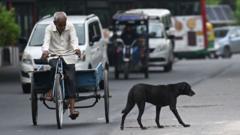Delhi's top court has mandated that authorities round up stray dogs across the city and its suburbs within an eight-week timeframe, driven by increasing incidences of dog bites and the associated risk of rabies. The court's decision arises from escalating public safety concerns, particularly for young children, who are especially vulnerable to rabies. Municipal sources estimate the stray dog population in Delhi could be around one million, with nearby areas like Noida, Ghaziabad, and Gurugram also experiencing similar challenges.
According to the World Health Organization, India accounts for a staggering 36% of global rabies-related fatalities, creating an urgent need for action. In a formal statement, the court emphasized that children "should not be left to fall prey to rabies" and directed that multiple animal shelters be constructed, each with the capacity to accommodate at least 5,000 dogs. These shelters are to include sterilization and vaccination facilities, alongside security measures such as CCTV surveillance.
The court's ruling also stipulated that sterilized dogs should not be returned to public areas, challenging existing protocols that allow for their release at the capture sites. Additionally, officials were instructed to establish a helpline within a week to facilitate reporting of dog bites and rabies cases.
However, the directive has faced significant backlash from animal welfare organizations. Activists argue the pace of the court's mandate is impractical, noting that most Indian cities lack sufficient resources to effectively rehabilitate their stray dog populations. Nilesh Bhanage, founder of PAWS, a prominent animal rights group, criticized the lack of feasible plans, suggesting that more attention should be focused on enhancing current regulations aimed at controlling dog populations through vaccination, sterilization, and garbage management.
Government data for 2024 reports 3.7 million cases of dog bites across India, but many fear the true extent of rabies-related deaths remains underreported. The WHO suggests that the disease claims between 18,000 and 20,000 lives annually in India. Despite this, recent parliamentary submissions indicate only 54 deaths were officially recorded in 2024, a slight increase from 50 the previous year.
As the deadline approaches, the debate between ensuring public safety and protecting animal rights continues, showcasing the complex relationship between urban wildlife and human population dynamics in India.
According to the World Health Organization, India accounts for a staggering 36% of global rabies-related fatalities, creating an urgent need for action. In a formal statement, the court emphasized that children "should not be left to fall prey to rabies" and directed that multiple animal shelters be constructed, each with the capacity to accommodate at least 5,000 dogs. These shelters are to include sterilization and vaccination facilities, alongside security measures such as CCTV surveillance.
The court's ruling also stipulated that sterilized dogs should not be returned to public areas, challenging existing protocols that allow for their release at the capture sites. Additionally, officials were instructed to establish a helpline within a week to facilitate reporting of dog bites and rabies cases.
However, the directive has faced significant backlash from animal welfare organizations. Activists argue the pace of the court's mandate is impractical, noting that most Indian cities lack sufficient resources to effectively rehabilitate their stray dog populations. Nilesh Bhanage, founder of PAWS, a prominent animal rights group, criticized the lack of feasible plans, suggesting that more attention should be focused on enhancing current regulations aimed at controlling dog populations through vaccination, sterilization, and garbage management.
Government data for 2024 reports 3.7 million cases of dog bites across India, but many fear the true extent of rabies-related deaths remains underreported. The WHO suggests that the disease claims between 18,000 and 20,000 lives annually in India. Despite this, recent parliamentary submissions indicate only 54 deaths were officially recorded in 2024, a slight increase from 50 the previous year.
As the deadline approaches, the debate between ensuring public safety and protecting animal rights continues, showcasing the complex relationship between urban wildlife and human population dynamics in India.



















